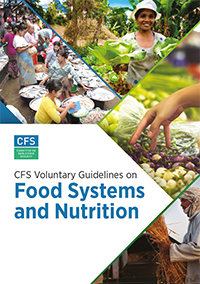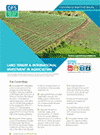CFS Policy Products
Using a multi-stakeholder, inclusive approach, CFS develops and endorses policy recommendations and guidance on a wide range of food security and nutrition topics.
These are developed starting from scientific and evidence-based reports produced by the High-Level Panel of Experts on Food Security and Nutrition (HLPE) and/or through work supported technically by the Food and Agriculture Organization of the United Nations (FAO), The International Fund for Agricultural Development (IFAD), World Food Programme (WFP) and representatives of the CFS Advisory Group.
Major policy products

Voluntary Guidelines on Gender Equality and Women's and Girls' Empowerment in the Context of Food Security and Nutrition
The CFS Voluntary Guidelines on Gender Equality and Women’s and Girls’ Empowerment in the Context of Food Security and Nutrition, endorsed at CFS 51 in October 2023, provide Members and other stakeholders with policy guidance on how to advance gender equality, women’s and girls’ rights, and women’s empowerment as part of their efforts to eradicate hunger, food insecurity and malnutrition.

Voluntary Guidelines on Food Systems and Nutrition
The CFS Voluntary Guidelines on Food Systems and Nutrition (VGFSyN) were endorsed at CFS 47 in February 2021. Resulting from a five-year intensive and inclusive multi-stakeholder consultation process and informed by the scientific evidence provided by the CFS High Level Panel of Experts, the Guidelines aim to support countries to eradicate hunger and malnutrition in all its forms by utilizing a food systems lens.

Framework for Action for Food Security and Nutrition in Protracted Crises
The objective of the Committee on World Food Security (CFS) Framework for Action for Food Security and Nutrition in Protracted Crises (CFS-FFA, the Framework) is to improve the food security and nutrition of populations affected by, or at risk of, protracted crises by addressing critical manifestations and building resilience; adapting to specific challenges; and contributing to addressing underlying causes.
The CFS-FFA is a short document that provides a broad framework that can be used by all stakeholders who may have a role in improving or impacting food security and nutrition in protracted crises.


Voluntary Guidelines on the Responsible Governance of Tenure of Land, Fisheries and Forests in the Context of National Food Security
The purpose of these Voluntary Guidelines is to serve as a reference and to provide guidance to improve the governance of tenure of land, fisheries and forests with the overarching goal of achieving food security for all and to support the progressive realization of the right to adequate food in the context of national food security.

Global Strategic Framework for Food Security and Nutrition
The Global Strategic Framework for Food Security and Nutrition (GSF) is a single, living document to be approved by the CFS Plenary. Its purpose is to improve coordination and guide synchronized action by a wide range of stakeholders. The GSF will be flexible so that it can be adjusted as priorities change. It was last updated in 2021.

Voluntary Guidelines to support the progressive realization of the right to adequate food in the context of the national food security
The objective of the Voluntary Guidelines is to provide practical guidance to States in their implementation of the progressive realization of the right to adequate food in the context of national food security, in order to achieve the goals of the World Food Summit Plan of Action. They provide an additional instrument to combat hunger and poverty and to accelerate attainment of the Millennium Development Goals.
The Voluntary Guidelines represent the first attempt by governments to interpret an economic, social and cultural right and to recommend actions to be undertaken for its realization. Moreover, they represent a step towards integrating human rights into the work of agencies dealing with food and agriculture.
CFS Policy Recommendations
Strengthening Collection and Use of Food Security and Nutrition (FSN) Data (CFS 51, 2023)
Promoting Youth Engagement and Employment in Agriculture and Food Systems for Food Security and Nutrition (CFS 50, 2022)
Agroecological and other innovative approaches for sustainable agriculture and food systems that enhance food security and nutrition (CFS 48, 2021)
Sustainable forestry for food security and nutrition (CFS 44, 2017)
 | Policy recommendations | HLPE Report | |
|
With a core focus on the following SDGs: |
With contributions to SDGs: |
|
 | Policy recommendations | |
|
With a core focus on the following SDGs: |
With contributions to SDGs: |
|
 | Policy recommendations | HLPE Report | |
|
With a core focus on the following SDGs: |
With contributions to SDGs: |
|
 | Policy recommendations | HLPE Report | |
|
With a core focus on the following SDGs: |
With contributions to SDGs: |
|
 | Policy recommendations | HLPE Report | |
|
With a core focus on the following SDGs: |
With contributions to SDGs: |
|
 | Policy recommendations | HLPE Report | |
|
With a core focus on the following SDGs: |
With contributions to SDGs: |
|
 | Policy recommendations | HLPE Report | |
|
With a core focus on the following SDGs: |
With contributions to SDGs: |
|
 | Policy recommendations | HLPE Report | |
|
With a core focus on the following SDGs: |
With contributions to SDGs: |
|
 | Policy recommendations | HLPE Report | |
|
With a core focus on the following SDGs: |
With contributions to SDGs: |
|
 | Policy recommendations | |
|
With a core focus on the following SDGs: |
With contributions to SDGs: |
|
 | Policy recommendations | |
|
With a core focus on the following SDGs: |
With contributions to SDGs: |
|
 | Policy recommendations | HLPE Report | |
|
With a core focus on the following SDGs: |
With contributions to SDGs: |
|
 | Policy recommendations | HLPE Report | |
|
With a core focus on the following SDGs: |
With contributions to SDGs: |
|



